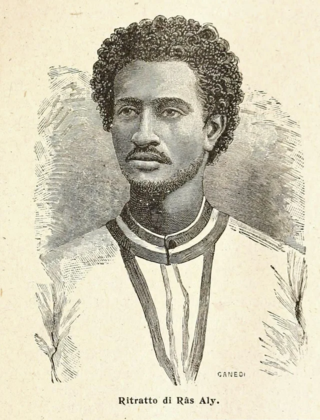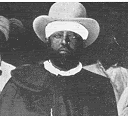
Tekle Giyorgis I, throne name Feqr Sagad, was Emperor of Ethiopia intermittently between 20 July 1779 and June 1800, and a member of the Solomonic dynasty. He was the youngest son of Yohannes II and Woizoro Sancheviyer, and the brother of Tekle Haymanot II.
Hezqeyas was Emperor of Ethiopia from 26 July 1789 to January 1794, and a member of the Solomonic dynasty. He was the son of Iyasu III.
Baeda Maryam II was Emperor of Ethiopia from 15 April to December 1795. He may have been the son of Salomon II. Although E. A. Wallis Budge, in his book A History of Ethiopia: Nubia and Abyssinia, notes some authorities believe Baeda Maryam was the same person as Salomon III, Nathaniel Pearce, who met the former Emperor when he visited Ras Wolde Selassie 20 January 1813, states that he had been Emperor only once, for nine months.
Yonas was Emperor of Ethiopia from 18 August 1797 to 4 January 1798, and a member of Solomonic dynasty. He was the son of Letezum, and the grandson of the Emperor Fasilides.
Egwale Seyon, throne name Newaya Sagad, was Emperor of Ethiopia from June 1801 to 12 June 1818, and a member of the Solomonic dynasty. He was the son of Hezqeyas.
Yimam of Yejju was a Ras of Begemder and Enderase (regent) of the Emperor of Ethiopia. He was the son of Gugsa of Yejju.
Aligaz of Yejju was Ras of Begemder, and Inderase (regent) of the Emperor of Ethiopia. He was the son of Abba Seru Gwangul and brother of Ali I of Yejju; he became both Ras and Inderase following Ali's death. Aligaz had four sons: Dejazmach Birru, Dejazmach Gobeze, Dejazmach Faris, and Dejazmach Gojjee.
Ali I of Yejju was Ras of Begemder, and following the death of Ras Mikael Sehul, Regent of the Emperor of Ethiopia. He was the son of Abba Seru Gwangul, chieftain of the Yejju, and Woizero Gelebu Faris, daughter of Ras Faris of Lasta.

Ali II of Yejju was Ras of Begemder and the de facto ruler of the Ethiopian Empire. He was a member of a powerful Oromo dynasty known as the Yejju, which ruled much of the Ethiopian Empire during the Zemene Mesafint.

Mikael Sehul was a nobleman who ruled Ethiopia for a period of 25 years as regent of a series of weak emperors. He was also a Ras or governor of Tigray 1748–71 and again from 1772 until his death. He was a major political figure during the reign of Emperor Iyasu II and his successors until almost the time of his death.
Wolde Selassie was Ras of the Tigray province between 1788 and 1816, and Regent of the Ethiopian Empire between 1797 and 1800. John J. Halls, in his Life and Correspondence of Henry Salt, preserves a description of this powerful warlord, as "small in stature, and delicately formed, quick in his manner, with a shrewd expression, and considerable dignity in his deportment." Nathaniel Pearce also notes that Ras Wolde was an avid chess player, and "would play at from morning till night".

Sabagadis Woldu was a governor of Tigray Province of the Ethiopian Empire from 1822 to 1831. Sabagadis gained some notoriety in the first decade of the 19th century for rebelling a number of times against his overlord, Ras Wolde Selassie. But just before the death of Wolde Selassie it seems that he made up with his master and became one of his loyal lieutenants. Following Wolde Selassie's death in 1816, he defied the authority of Wolde Selassie's son, and became the most powerful warlord in Tigray. Making Adigrat his capital, he ruled Tigray and a small strip of the coastal plains of Eritrea by 1818. His rule also extended to the Eritrean highlands.
The Battle of Debre Abbay, also known as the Battle of Mai Islami, was a conflict between Ras Marye of Yejju, Regent of the Emperor of Ethiopia, and his rival from Tigray, Dejazmach Sabagadis of Agame. Although Ras Marye lost his life in the battle, Dejazmach Sabagadis was defeated and executed by Ras Marye's followers after surrendering.

The Zemene Mesafint was a period in Ethiopian history between the mid-18th and mid-19th centuries when the country was ruled by a class of regional noblemen and the emperor was merely a figurehead. For the most part, the regional lords were tightly related by marriage and constituted a stable ruling elite that prevailed until the mid 20th century. In short, during the Zemene Mesafint, the Emperors from the Solomonic dynasty were reduced to little more than figureheads confined to the capital city of Gondar.

Gugsa Welle, also known as Gugsa Wale, Gugsa Wolie and Gugsa Wele, was an army commander and a member of the imperial family of the Ethiopian Empire. He represented a provincial ruling elite which was often at odds with the Ethiopian central government.
The Battle of Anchem was a battle fought between two factions of the Royal family in the Ethiopian Empire. The battle was fought to determine who would rule the empire, Empress Zewditu or King (Negus) Tafari Makonnen.

Wube Haile Maryam of Semien, (1799-1867), also called by his title Dejazmach Wube, Webé; his name is also given in European sources as ‘‘Ubie’’. Wube was one of the major figures of 19th century Ethiopia, during the closing decades of the Zemene Mesafint a period of regional lords vying for power, prestige and territory amid a weakened authority of the emperors.
Menen Liben Amede was Empress consort of Ethiopia by marriage to Emperor Yohannes III in 1840–1841, 1845 and 1850–1851.
Haile Maryam Gebre of Semien, Horse name: Abba Dammana was an early 19th century governor of Semien, Welkait and Wogera. Haile Maryam tried to hold his hereditary possessions in the face of continuous pressure from rival lords during Ethiopia's Zemene Mesafint era. He is remembered as the guardian of Waldeba monastery.
Gebre Tasfa better known as Gebre of Semien was the governor of Semien, Tsegede, Welkait and Wogera during the late 18th and early 19th century in Ethiopia. He held the title of Ras, and had an unusually long reign spanning 44 years during the tumultuous Zemene Mesafint when lords of each province and district continuously fought each other for supremacy. Ras Gebre was the primary backer of his son-in-law Emperor Tekle Giyorgis I claims to the throne.